Japanese Easy to to the Right Thing Hard to Do the Wrong Thing

30 Things (Not) To Do In Japan - Easily Avoid These Embarrassing Moments!
Date published: 14 October 2019
Last updated: 8 January 2021
Each country has its own specific rules, habits, culture, and practices which differ from our own. Japan is no different. There are many things in Japan that many foreigners who are visiting may not be aware of and might inadvertently disrupt, offend or anger the locals.
Although a lot of these things may seem like they are just tiny details or would be overlooked and forgiven because you are just passing through, it is always a good idea to inform yourself as much as possible about a country's customs and culture. As a representative of your own country, being polite, courteous and knowledgeable about the country you visit goes a long way.
To help you better understand and enjoy your visit to Japan, here are a list of things that many foreigners do that you should try to avoid!
In this article:
・1. Shoes and when/where to take them off
・2. Chopstick abuse
・3. Train etiquette
・4. Out and about
・5. Hot Springs
・6. Around your accommodations
・7. Social Situations
Shoes and when/where to take them off
1. Shoes are often removed at home, work, restaurants and schools
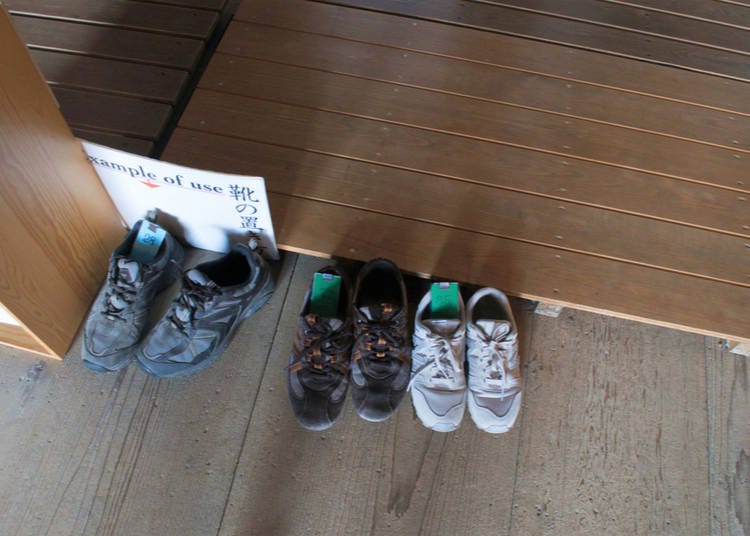
Many people know that many Asian countries have a no-shoe policy inside the home, but you might not know that a lot of workplaces, restaurants, schools and even many hotels require everyone to remove their shoes and wear slippers or indoor shoes.
If you are just visiting Japan, most likely you won't be entering a school or workplace but there is a good chance you will eat at a Japanese style restaurant or izakaya. Most of these restaurants have a shoe locker at the entrance to place shoes before entering the dining area—especially if the restaurant has tatami mat flooring.
In these establishments, shoes and slippers are not permitted. Also, if you are staying at a hostel, capsule hotel or Japanese style ryokan than most require you to remove your shoes at the entrance and change into the provided slippers. Be careful to make sure not to step on the shoe area with slippers and vice versa.
When visiting a Japanese home, remove your shoes at the entrance or genkan. There will often be slippers provided to change into but if not, entering with socks is okay. If slippers are provided, it is polite to wear these slippers in the home but to remove them if going into a tatami floor room.
2. Bathroom slippers
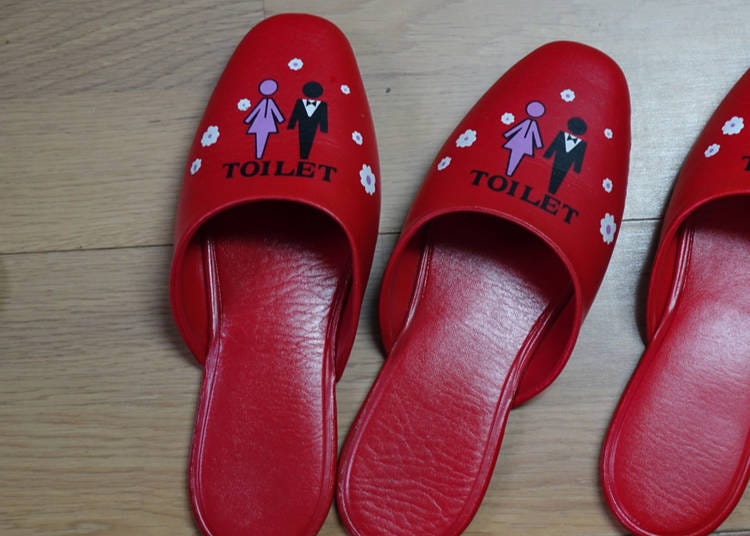
Image: NCSchneider_Images / Shutterstock.com
A mistake I have made myself many times is to either walk into the bathroom using the same slippers worn in the home or restaurant, or to leave the bathroom wearing the bathroom slippers.
Slippers in the bathroom are for bathroom use only and wearing them accidentally into the dining area or home area might cause some shocked and disgusted faces. If you do accidentally make this mistake, make sure to apologize to anyone around who notices.
3. No slippers on tatami
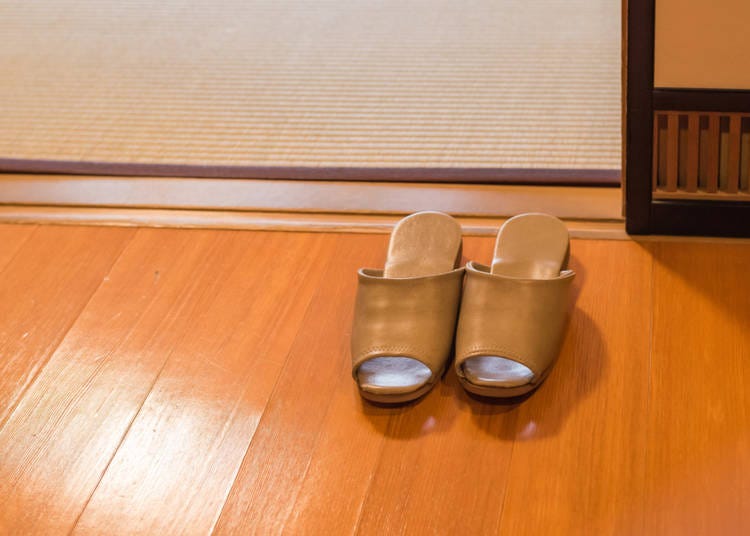
It may seem strange that despite removing outdoor shoes, indoor slippers are not permitted on tatami floors but this has more to do with the fragility of the flooring than cleanliness. Tatami floors are extremely delicate and difficult to clean. In fact, when leaving or moving into an apartment, there is a separate fee charged to clean or replace the tatami mats.
The mats can be easily damaged, scratched or stained so ensuring heavy furniture and footwear don't rupture the tatami is important. For this reason, entering rooms with tatami floors require socks or bare feet only.
4. Shoes facing the right way
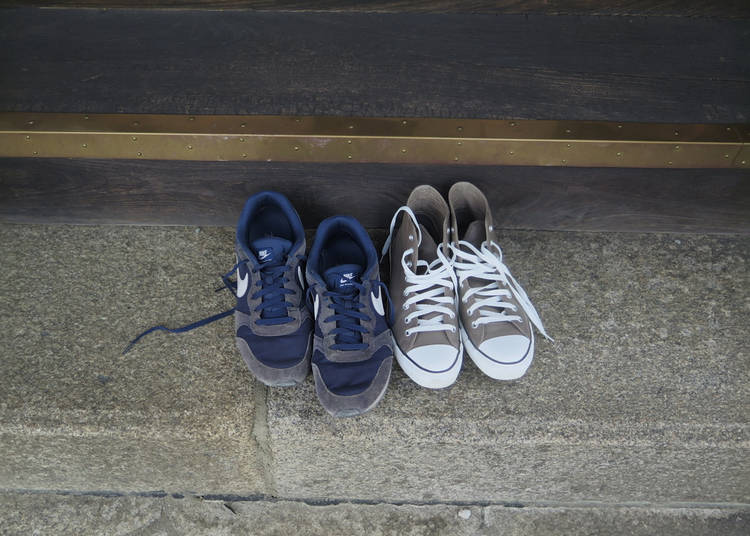
Image: jesuspereira / Shutterstock.com
This is actually a small detail that many Japanese even forget about themselves but can show your Japanese hosts that you are considerate and have done your research. The proper way to leave shoes is to have them facing out so they are easy to put on when exiting and to leave slippers facing in towards the home so they are easy to slip into when entering.
Chopstick abuse
5. Poking them in rice

It might seem convenient and even effective to stick your chopsticks in the rice to avoid dropping them, having them roll away or dirty the table but this is probably the most unacceptable and taboo way to handle chopsticks as it symbolizes death. At Japanese funerals, chopsticks are stuck into the rice facing upwards during the funeral rituals and remind Japanese people of death. It is also a symbol of bad luck so definitely something to avoid when eating out.
6. Rubbing them together
Many people outside of Japan often rub chopsticks together to ensure that any splinters are brushed away, but this is not done in Japan. When I was in Canada, everytime I went to an Asian restaurant, everyone around me did this so I assumed it came from Japanese culture—but in Japan no Japanese people will do this and it will definitely get you many awkward glances if you do.
7. Passing stick to stick

When passing food from person to another, it is important that the person passing the food, using the chopsticks transfers the food to a plate and not to someone else's chopsticks. It may seem that you are being courteous by accepting the food from someone else's chopsticks to yours but this is quite taboo as once again it brings about images of death and funerals. Once the body is cremated in a funeral, family members using chopsticks pass charred bone fragments to each other in the ritual.
Train etiquette
8. Talking too loud on trains

Trains are public spaces and a variety of people are traveling with friends, family or tour groups so socializing and talking seems like a good way to pass the time. However, in Japan, especially in big cities like Tokyo, many people commute long distances for work and have very little quiet time to sleep or decompress.
Train rides are a popular place for Japanese people to take a nap, catch up on their reading or quietly play their favorite smartphone game. So when someone on the train is talking and laughing loudly it disturbs the peaceful journey. In general, Japanese people don't talk very loudly in public and trains, stations, malls and streets will be comparatively quieter than other countries.
9. Sitting in the priority seats
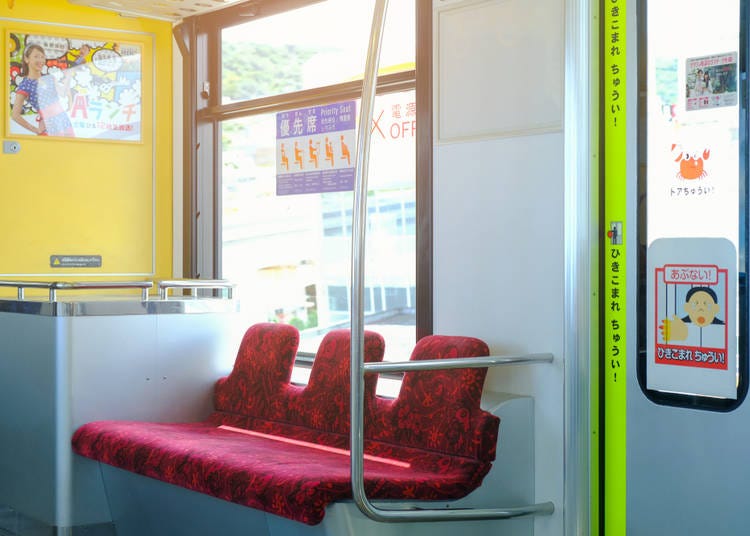
Image: tong patong / Shutterstock.com
There are designated areas on every train and bus usually labelled with a priority seating sign and have seats that differ in color from the rest of the seating. These seats are specifically assigned for people with disabilities, sicknesses, pregnancy and for seniors. If possible you should avoid sitting in these seats, and if you happen to be sitting in one, be sure to get up when someone who you think needs it approaches. Japanese are very hesitant to ask for seats so unless you offer it they may stand despite requiring the seat more than you.
10. Talking on the phone

Using your phone on the train or bus anywhere except near the priority seat area is acceptable as long as you are not using it for talking. Texting, emailing, gaming, listening to music or watching videos is fine as long as you are using headphones and the sound is not disturbing passengers around you. But talking on the phone, even with a Bluetooth headset, is not allowed. If you need to use your phone in an emergency and it can't wait until the next stop, stand near the door and talk quietly while holding your hand over your mouth area to reduce sound from carrying over.
11. Putting bags or luggage on seats

This has been a major complaint by many Japanese commuters who share trains with many tourists coming from or heading to the airport. Carrying big suitcases and backpacks takes up a lot of room in an already full train but taking up seats for your luggage is definitely frowned upon. If possible put bags and backpacks overhead and keep suitcases in front of you rather than stacking them on the seat next to you. Keeping bags as close to you as possible will also ensure the center of the train has a clear and easy path to the doors.
12. Skipping lineups
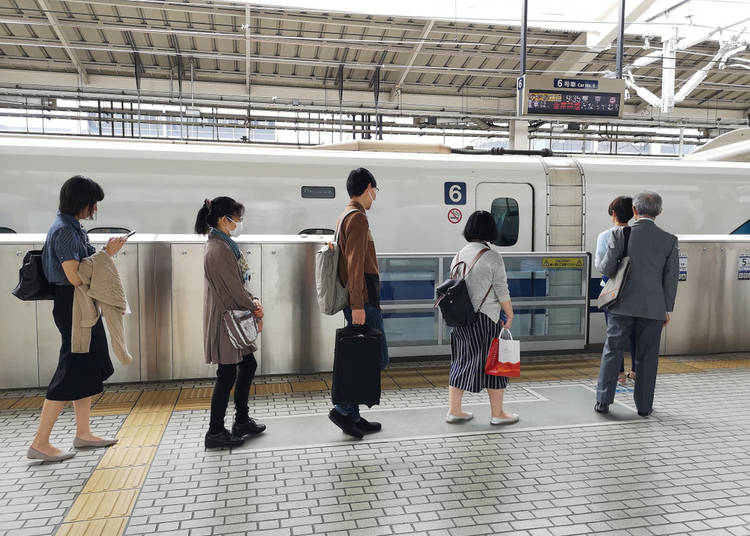
Image: Cheng Wei / Shutterstock.com
Some countries have no specific line or boarding sequence so when the train or bus arrives, everyone rushes in before the doors close. But Japan loves lines and whether you are waiting for a ride at Disneyland, a seat at a ramen restaurant or for the next train or bus, there is a clear and usually marked area where people stand to enter. When the train arrives, it is polite to let people exit before entering yourself. And definitely boarding in an organized manner is a must.
Out and about
13. PDA

Image: Michael J P / Shutterstock.com
PDA or public displays of affection might be common in your country but in Japan most couples will avoid kissing or hugging in public. Holding hands is popular, though. Even when first meeting up with a girlfriend or boyfriend or saying goodbye at the end of the night, Japanese people rarely hug or kiss. Foreigners who are on vacation and especially on a honeymoon or date might want to express their feelings but being as discreet as possible might be a good idea as Japanese people are not used to seeing such intimate moments out in public.
14. Walking and eating

Walking and eating are generally looked down upon in Japan. Especially when in public areas that are crowded or congested. No one wants to be walking behind someone munching on food when trying to get to their destination. Along with the chances of dropping food as you walk, slowing down the crowds of people rushing to get to work may cause many Japanese to give you the stink eye.
There are situations though, that eating and walking are appropriate. For example, many festivals and streets that have food stalls will have people buying and consuming the foods sold at the stalls while strolling around and enjoying the sights. Also, during cherry blossom viewing parties, many people drink and eat in the parks under the cherry blossom trees. It will be common to see people with food and alcohol admiring the flowers and socializing with groups around the park.
15. Blowing your nose in public

You would think blowing your nose with a tissue is common courtesy and would much rather be preferred to someone wiping their nose on their shirt or constantly sniffing. However, blowing your nose in public, specifically on the train or in close quarters to people like at a meeting or at a restaurant table is considered rude.
The sound of blowing your nose into a tissue is loud and piercing to the ears and with a lack of garbage cans in Japan, it's hard to find a place to throw away used tissues. For this reason, most people excuse themselves and go to the bathroom to blow their nose or more commonly keep sniffing until they are alone and can blow their nose in private. If you have a runny nose though, dabbing your nose with a tissue is quite acceptable.
16. Trying to open a taxi door manually
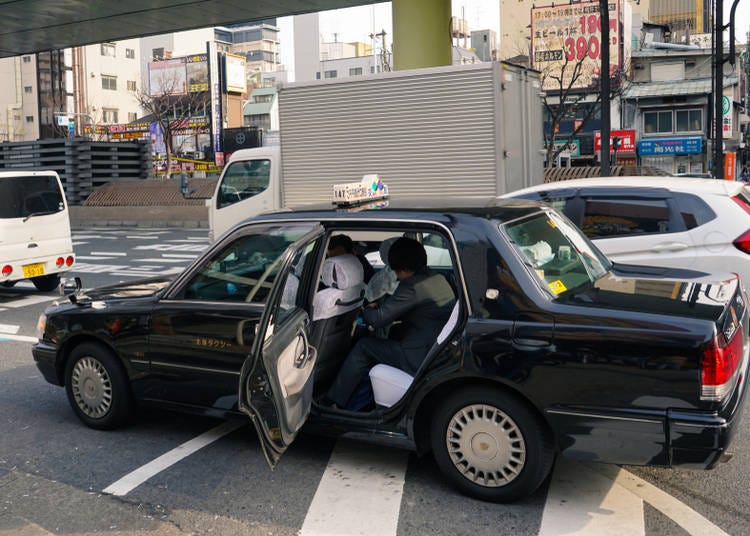
Image: NP27 / Shutterstock.com
Many foreigners who visit Japan for the first time don't realize that taxis in Japan have back doors that open automatically by the driver. Unlike other countries where you open the back door yourself and get in, Japanese taxis require that you wave down the driver and wait until he or she opens the back door before you enter. Partly because of Japan's love of technology and partly for security and safety reasons, the driver controls the flow in and out of their taxi.
If you are a group and require someone to sit in the front, you can manually open the front door as the automatic doors only apply to the back. Exiting the taxi when in the back also requires the driver to automatically open the door after you have paid the fare.
17. Facing the wrong way on the squat toilet
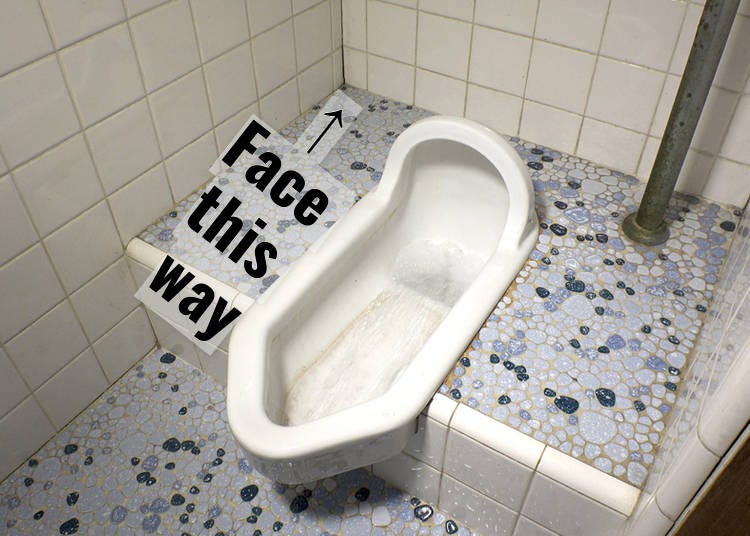
Depending on the country you grew up in, traditional Japanese squat toilets might be a complete mystery. For those not accustomed to this type of toilet, I highly recommend using a Western style toilet if one is available. But many older areas of Japan and train stations might still only have these older types of toilets available. If you do have to use these toilets, avoid using it the wrong direction. I am guilty of doing this when I first had to use a squat toilet. I assumed I should face outwards facing the stall door like you do when sitting on a western-style toilet. However, you face inwards facing the raised part (the hood) of the toilet.
Another piece of advice, if your body is not used to squatting you will probably have trouble bending in the right position so if there are handlebars like you would find in a wheelchair accessible toilet, you might want to hold on to those. Some public toilets may not have toilet paper either, so you should always carry some packages of tissues, just in case.
18. Standing on the wrong side of the escalator
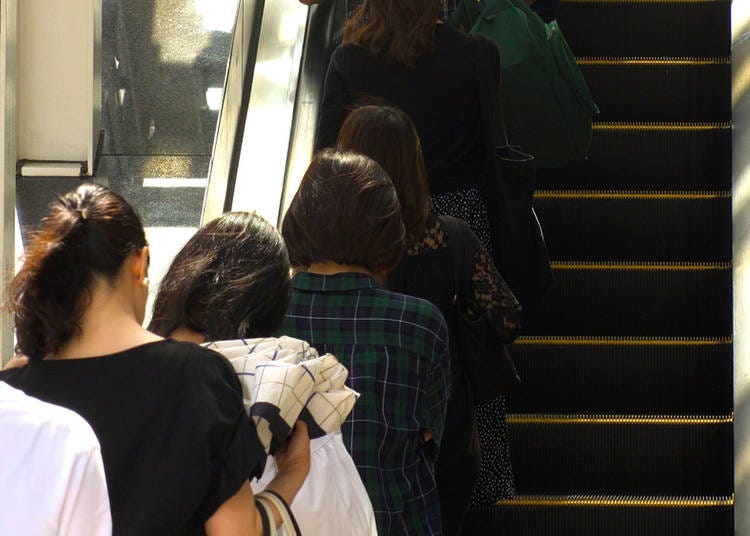
When using escalators, especially in train stations, there are crowds of people rushing to get to work or their desired destinations. There are also many people on vacation, seniors or students socializing or families heading to events. For those in a hurry, the escalator has a system with one side standing and the other walking. This allows those who want to quickly commute to avoid getting stuck behind those who are moving at a leisurely pace.
Many foreign visitors are not aware of this and stand on both sides of the escalator blocking the flow for those wanting to pass. The general rule is that people stand on the left side of the escalator and pass on the right. However, in the Osaka area it is the opposite with people passing on the left.
Hot Springs
19. Wearing bathing suits in the hot spring

Onsen or hot springs in Japan, are a traditional and widely popular pass time in Japan with over 138 million people visiting hot springs each year. Most are separated into male and female but there are also some co-ed hot springs as well. Co-ed hot springs usually require wearing a towel or bathing suit. And there are some public onsen for families or groups that allow bathing suits, but generally you must be naked to enter most hot springs. Bathing nude in a public space with strangers might sound intimidating but is quite a refreshing and liberating experience.
20. Dipping towels into the hot spring water

Most Japanese use small towels to cover themselves when they undress and leave their clothes in baskets in the changing room. They move from the change room to the shower area and then to the hot spring pools with their towels in place. You can bring the small towel into the hot spring area and cover your private parts until you enter the pool and place the towel on your head when soaking in the hot spring water. It is not okay to rinse your towel in the water and must stay above water at all times.
21. Not showering before getting into the onsen
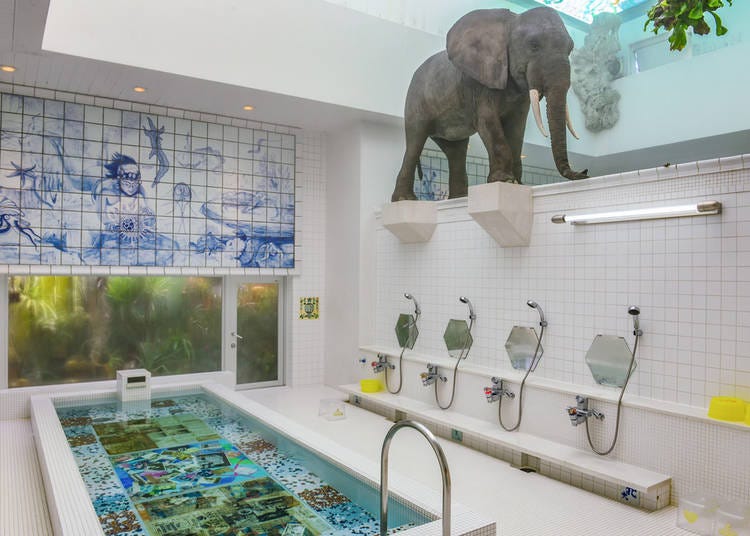
Image: rayints / Shutterstock.com
Another mistake many foreigners make when undressing and heading into the hot spring area is to go directly from the changing room to the hot pool of water. This however, is extremely inconsiderate as everyone shares the same water so keeping the hot spring water as clean as possible is a must. Everyone must thoroughly clean their hair, face and body with shampoo and soap before entering hot spring water—and be sure to rinse properly before entering the communal water! Similarly, after finishing your deep soak, showering with soap and shampoo is also a common practice.
Around your accommodations
22. Garbage separation
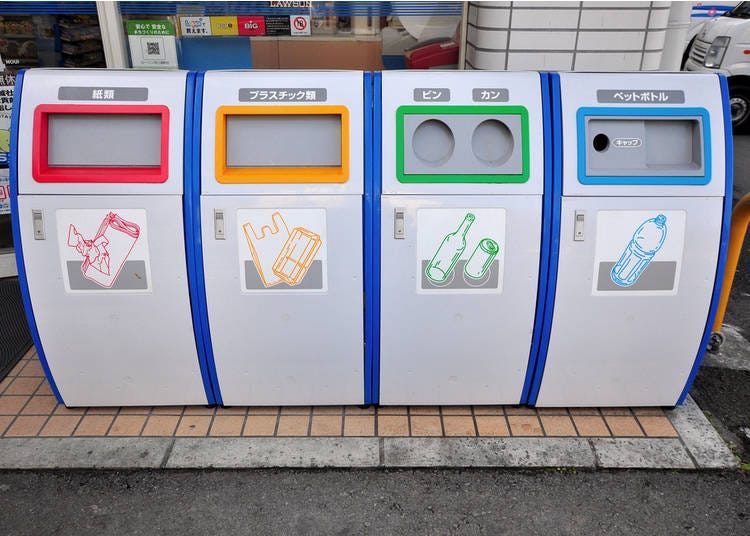
Image: happycreator / Shutterstock.com
If you are staying at a hotel, this might not be something you will deal with but those staying at hostels, Airbnb, or guest houses will most likely deal with the intricate rules of garbage separation. Also, tourists out and about will find garbage cans in convenience stores, train stations and attractions around Japan that have similar rules and garbage divisions.
Garbage in Japan is separated into burnable and unburnable. There are also further divisions between bottles, cans, PET bottles, plastics and large objects. If you are staying in a place that has many garbage receptacles, it is best to ask the owners or staff for a detailed explanation or see if there are signs describing which garbage goes where.
23. Loud noises at night

With limited space, Japanese housing tends to be narrower and congested. The actual construction of housing also uses thinner walls and little insulation. For this reason sounds seems to travel through walls much easier, making noisy neighbors a big problem.
And unlike other parts of the world, entertaining guests, having parties, playing instruments or listening to music really loudly in homes is generally not done. Most Japanese people try to keep noise down to a minimum after 10 pm.
If you are having a party, watching television at a high volume, screaming, laughing or singing loudly late at night, you will most likely hear a banging on the wall letting you know that others around you can hear you and are not pleased.
The last thing you want is to have awkward encounters with neighbors in the hallways so being considerate of noise is a good idea.
24. Doing laundry or vacuuming at night

Being studious and doing your chores and housework is admirable but make sure chores like vacuuming or using the washing machine are done in the day or on the weekend. As mentioned before, noise travels quite easily and loud noises can easily be heard through walls. Planning your days to be polite and considerate to neighbors will go along way to having a harmonious relationship with Japanese people around you.
Social Situations
25. Calling yourself by the honorific "san"

This is more embarrassing than rude and will most likely get chuckles from Japanese people but it is something that many foreigners have done when introducing themselves in Japanese.
Unlike English where you may introduce yourself as Mr. or Mrs. so and so, in Japanese the related word "san" is only to be used for addressing others. Calling Japanese people their surname with the honorific san after, is a respectable way to address them. So for someone named Mamoru Tanaka, calling them Tanaka-san would be appropriate.
"San" is also used for both male and female and doesn't distinguish between married or single. Usually elders will call younger people or children "chan" (female) or "kun" (male) but it is quite informal so it's recommended to stick with "san" even if you are older than the person you are addressing.
26. Wearing a black tie at a wedding
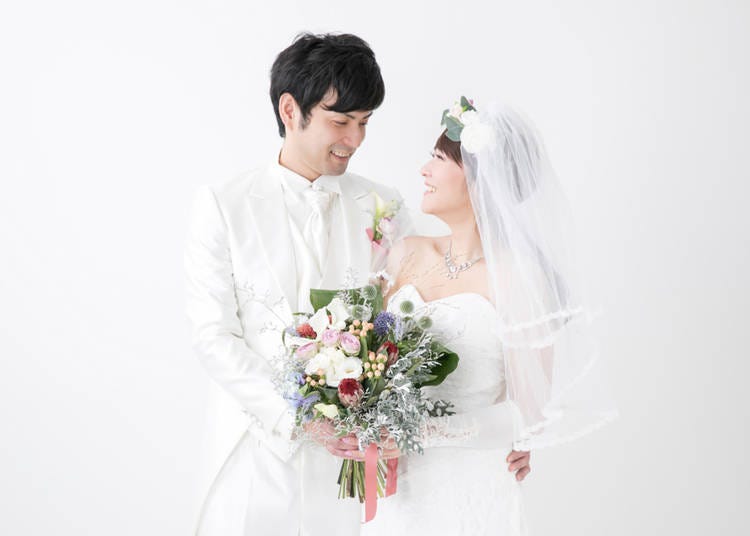
Unfortunately, I found out this little tidbit of information too late. I assumed like weddings in North America, tuxedos and black-tie affairs like weddings would obviously have black ties. However, in Japan, black ties are only worn at funerals as they are a symbol of sadness and mourning. Most men at weddings wear white ties including the groom and groomsmen. And black clothes in general are not often worn during happy occasions.
In fact, not only at weddings but in every situation except a funeral a black tie should be avoided. However black ties which have a design or stripes are acceptable.
27. Taking the last piece of food when sharing
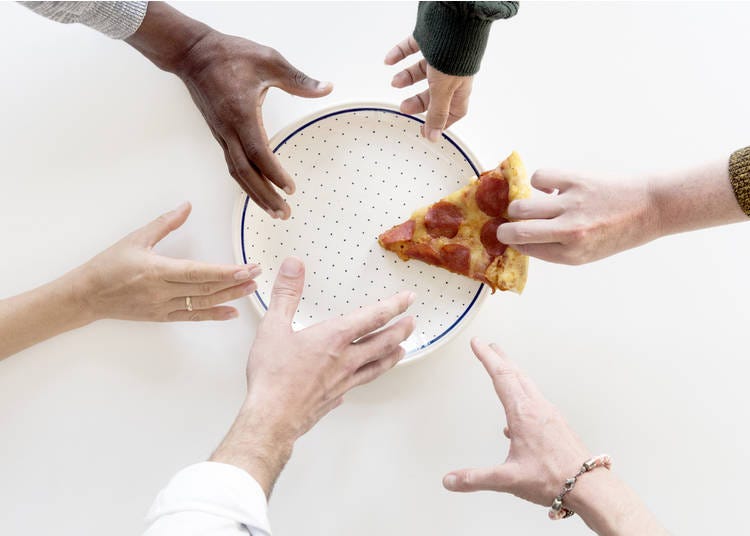
This might be a general rule in many countries but Japanese people are extra cautious to take the last piece of food from a communal plate. When eating with a group, everyone will take one piece or serving of a food to ensure everyone has gotten their share. And as the night progresses, all the foods will slowly be eaten except the final leftovers in the plate. Some foreigners visiting Japan think that everyone is full and therefore proceed to take the last piece of everything assuming it will go to waste.
However, most likely everyone wants the last piece but is too polite to take it. In this situation many people will offer the last piece or serving to others and often people will negotiate a fair distribution of the food. It is polite to refuse the last piece if someone offers it the first time and eventually accept it if they insist.
28. Pouring a drink for yourself and not for others

This group dining etiquette is also a popular practice at weddings, work get togethers and social events with groups of people who you don't have close connections. Usually the host of the party or boss will go around the table pouring drinks for everyone. And as the night progresses and glasses empty, younger people will pour drinks for their elders or superiors.
Even if you are not in a formal situation, and are dining with Japanese friends, it is a good idea to pour drinks for someone else and have them pour for you. It is a social custom that will help build a stronger relationship with friends and colleagues.
29. Tipping
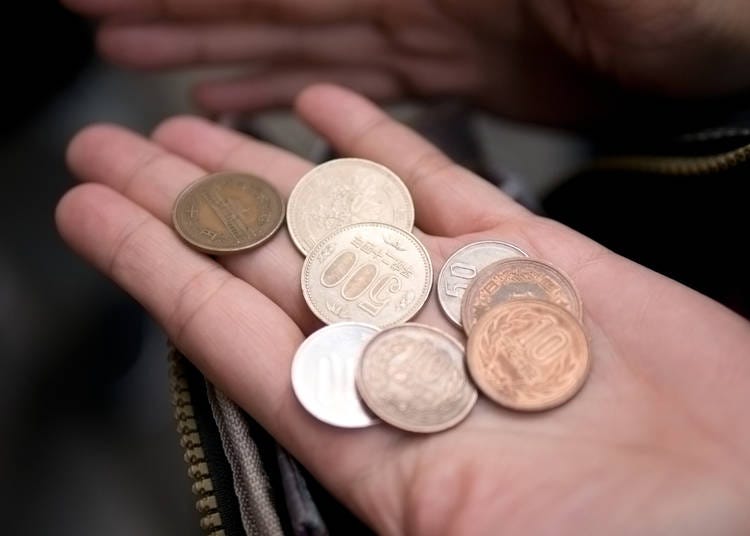
Tipping is not common in Japan and sometimes even refused. Leaving a tip at a table and walking out of the restaurant, you might find the server run outside, chase you down and return your money.
Service excellence is a part of the job and saying thank you or gochiso sama deshita ('Thank you for the feast') is enough to thank your server. Even at hotels, hair salons, taxis and other places you might be used to tipping at back home, staff in Japan will not expect or accept a tip. During my time in Japan, I have only tipped pizza delivery staff who at first were confused but thanked and appreciated the gesture. You might want to tip your tour guide or driver but it is not expected.
30. Handling of business cards
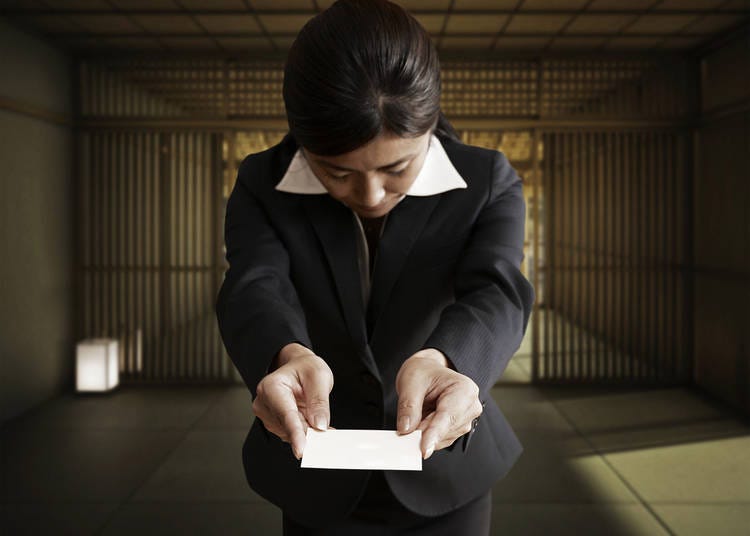
An integral part of doing business in Japan is the creation and keeping of relationships. Respect and honoring of connections builds long lasting partnerships. The first step of this process is the introduction which requires greetings, bowing and the passing of the business card. Much more valuable in Japanese society, the business card is revered and treated like the relationship being built.
It is important to hold the business card with both hands and formally pass the card into the awaiting hands of the receiver. While passing the cards, the person introduces their name, company and says Yoroshiku Onegai Shimasu which means I look forward to working with you. The card is then held carefully and placed on the table or counter in front of you until the meeting is over. Parting ways the card is still held in your hands and not placed in a pocket or bag until the person departs. Most Japanese people have a folder or case for all the business cards they have received to ensure they don't lose or damage the card.

As a foreigner in Japan, the good news is that many Japanese people are forgiving and quite helpful. Making a mistake might be embarrassing and frustrating, but Japanese people tend to understand and support foreigners, especially tourists. The important part is to learn from your mistakes and use them as a guide to better understand Japan, its people and culture. Showing respect and having an apologetic tone when making mistakes will show Japanese people that you are trying to learn and appreciate Japan and its unique values.
Written by:


*This information is from the time of this article's publication.
*Prices and options mentioned are subject to change.
*Unless stated otherwise, all prices include tax.
Source: https://livejapan.com/en/article-a0003666/
0 Response to "Japanese Easy to to the Right Thing Hard to Do the Wrong Thing"
Post a Comment